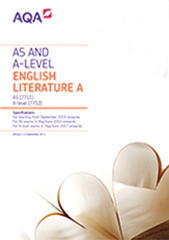Assessment objectives
Assessment objectives (AOs) are set by Ofqual and are the same across all AS and A-level English Literature specifications and all exam boards.
The exams and non-exam assessment will measure to what extent students have achieved the following AOs:
- AO1: Articulate informed, personal and creative responses to literary texts, using associated concepts and terminology, and coherent, accurate written expression.
- AO2: Analyse ways in which meanings are shaped in literary texts.
- AO3: Demonstrate understanding of the significance and influence of the contexts in which literary texts are written and received.
- AO4: Explore connections across literary texts.
- AO5: Explore literary texts informed by different interpretations.
Weighting of assessment objectives for AS English Literature A
| Assessment objectives (AOs) | Component weightings (approx %) | Overall weighting (approx %) | |
|---|---|---|---|
| Paper 1 | Paper 2 | ||
| AO1 | 14 | 14 | 28 |
| AO2 | 12 | 12 | 24 |
| AO3 | 12 | 12 | 24 |
| AO4 | 6 | 6 | 12 |
| AO5 | 6 | 6 | 12 |
| Overall weighting of components | 50 | 50 | 100 |
The specification reflects the belief that the assessment objectives (AOs) work best together, producing a rounded and holistic view of English literature. Students will need to show coverage of all AOs in all tasks. To be specific:
AO1 essentially requires informed and relevant responses which are accurately written and use appropriate concepts and terminology.
AO2 requires students to analyse ways in which meanings are shaped in literary texts, with particular focus on the structures of texts as a form of shaping.
AO3 relates to the many possible contexts which arise out of the text, the specific task and the period being studied.
This specification treats AOs 1, 2 and 3 as broadly equal, given their relative weightings: AO1 has a weighting of 28% whilst AOs 2 and 3 both have a weighting of 24%.
AO4 involves connections across texts and sees possible meanings and interpretations arising not only out of the contexts of the text itself (AO3 above) but also out of the wider and broader contexts which comes from the study of period. Thus even when an individual text is being investigated it should still be seen as being framed by a wider network of texts and contexts to which it connects.
AO5 completes the picture by acknowledging that if work in AOs 2, 3 and 4 had been included in the response to the question then debate and interpretations will arise out of this work showing that the interpretation of texts is not a fixed process but a dynamic one.
AOs 4 and 5 each have a weighting of 12% in all questions.
Weighting of assessment objectives for A-level English Literature A
| Assessment objectives (AOs) | Component weightings (approx %) | Overall weighting (approx %) | ||
|---|---|---|---|---|
| Paper 1 | Paper 2 | Non-exam assessment | ||
| AO1 | 11.2 | 11.2 | 5.6 | 28 |
| AO2 | 9.6 | 9.6 | 4.8 | 24 |
| AO3 | 9.6 | 9.6 | 4.8 | 24 |
| AO4 | 4.8 | 4.8 | 2.4 | 12 |
| AO5 | 4.8 | 4.8 | 2.4 | 12 |
| Overall weighting of components | 40 | 40 | 20 | 100 |
This specification reflects the belief that the assessment objectives (AOs) work best together, producing a rounded and holistic view of English literature. Students will need to show coverage of all AOs in all tasks. To be specific:
AO1 essentially requires informed and relevant responses which are accurately written and use appropriate concepts and terminology.
AO2 requires students to analyse ways in which meanings are shaped in literary texts, with particular focus on the structures of texts as a form of shaping.
AO3 relates to the many possible contexts which arise out of the text, the specific task and the period being studied.
This specification treats AOs 1, 2 and 3 as broadly equal, given their relative weightings: AO1 has a weighting of 28% whilst AOs 2 and 3 both have a weighting of 24%.
AO4 involves connections across texts and sees possible meanings and interpretations arising not only out of the contexts of the text itself (AO3 above) but also out of the wider and broader contexts which comes from the study of period. Thus even when an individual text is being investigated it should still be seen as being framed by a wider network of texts and contexts to which it connects.
AO5 completes the picture by acknowledging that if work in AOs 2, 3 and 4 had been included in the response to the question then debate and interpretations will arise out of this work showing that the interpretation of texts is not a fixed process but a dynamic one. In non-exam assessment only, discussion of different interpretations must include, on at least one text, consideration of different interpretations of the text(s) over time.
AOs 4 and 5 each have a weighting of 12% in all questions.
